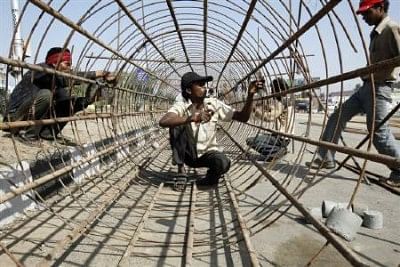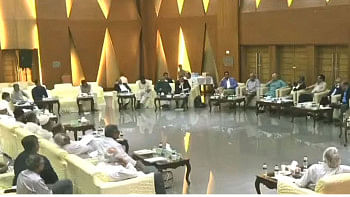India set for fair growth despite reform headwinds

Labourers work on reinforcing bars at a construction site to build a bridge on the outskirts of Ahmedabad, India.Photo: Reuters
Twenty years ago, India was in the throes of a balance-of-payments crisis that forced it to airlift 47 tonnes of gold to London to pledge with the Bank of England as collateral for an emergency $400 million loan.
Since that national humiliation, nearly 200 million people have climbed out of extreme poverty and India's share of global output has more than doubled. Per capita GDP, measured in dollars at purchasing power parity, has risen more than five-fold.
The architect of India's renaissance is the current prime minister, Manmohan Singh, who took over as finance minister in June 1991 and lit the blue touch paper for growth by dismantling the "Licence Raj" that had India tied up in red tape.
As prime minister, Singh has disappointed reformers.
He has failed to overcome opposition to market opening in sectors such as retailing and financial services; infrastructure, the sinews of any economy, is woeful; and a long-awaited national goods and service tax has still not been launched.
Given these shortcomings and Delhi's perennial struggle to cap inflation and the budget deficit, it speaks volumes for the underlying vibrancy of the economy that many forecasters remain confident about India's chances in coming years.
"I am very very hopeful of the next five to seven years. I think we can sustain this growth," said S. Narayan, who was economic adviser to former Prime Minister Atal Bihari Vajpayee.
The International Monetary Fund says India has the potential to grow between 8 percent and 8.5 percent a year over the medium term. Economists at Citi are even more bullish: they project 8.8 percent annual gross domestic product growth between 2010 and 2015, shading the rate of 8.7 percent pencilled in for China.
"I think 8 percent is the new normal," said Sanjaya Baru, editor of the Business Standard newspaper and Singh's former press adviser.
In his annual budget presented on Monday, Finance Minister Pranab Mukherjee forecast 9 percent growth in the fiscal year starting in April, up from an expected 8.6 percent this year.
The optimism is anchored by India's favourable age profile. With a young population, private saving increased from 24 percent of GDP in 2000 to 35 percent in 2009, fueling a spurt in investment-led growth. The working-age ratio will keep rising rapidly until 2021 before levelling off perhaps a decade later.
"The demographic dividend is projected to peak over the next two decades, adding about 2 percentage points to annual per capita income growth over the period," IMF economists Shekhar Aiyar and Ashoka Mody said in a recent Working Paper.
And as incomes rise, some households that now consume all they produce will be able to start saving for the first time.
As a result, the IMF expects India's gross savings to reach 41.7 percent of GDP by 2015, propelling investment to 44 percent of GDP from less than 38 percent today.
It all sounds too good to be true, and for Razeen Sally, director of the European Centre for International Political Economy, a Brussels research outfit, it is.
Sally bemoans "exuberant optimism" and says India is more protected against imports and inward investment than China and other regional rivals. Its public finances, infrastructure and lower-education system are also much weaker, he argues.
"Absent further market reforms, India will not have what it desperately needs: east Asian-style, labour-intensive agricultural, services and industrial growth," he wrote in a paper.
As expected, Mukherjee's budget was light on deep-seated reforms.
Narayan, the former adviser, is not optimistic about the prospects for market-opening measures, for instance to lure more foreign direct investment. But he and Baru, the newspaper editor, both said they were hopeful that Singh's agreement to hold an enquiry into a telecoms scandal would usher in better governance.
The country's auditor estimates that India lost up to $39 billion when the telecoms ministry gave out licences at below-market prices in 2007/2008.
The telecoms scandal is grist to the mill of those who argue that India's economy thrives despite, not thanks to, the government. In China, many would say the opposite is true, even though official corruption is widespread.
In GDP per capita, China and India were neck and neck at the start of the 1990s. Now the average Chinese is three times richer. India's share of world output has doubled since then, but China's has quadrupled. China's infant mortality rate is a third of that in India.
"China is a great success story and we need to do more to catch up. Certainly, among policy makers there is an awareness that China's economy is far stronger and its relations with the world are on a firmer footing," said Baru.
The overriding priority, he said, is to improve the quality of infrastructure -- from roads, railways and power to education, health care and urban services such as sanitation.
Narayan, who is head of research at the Institute of South Asian Studies at the National University of Singapore, said he would like India to emulate China's rapid construction of a high-speed cross-country rail network.
A 1,300 km, $33 billion line linking Beijing and Shanghai, due to open in June, was built in just over three years.
The inconvenient truth, though, is that things can get done faster in a single-party state than in a boisterous democracy.

 For all latest news, follow The Daily Star's Google News channel.
For all latest news, follow The Daily Star's Google News channel. 



Comments